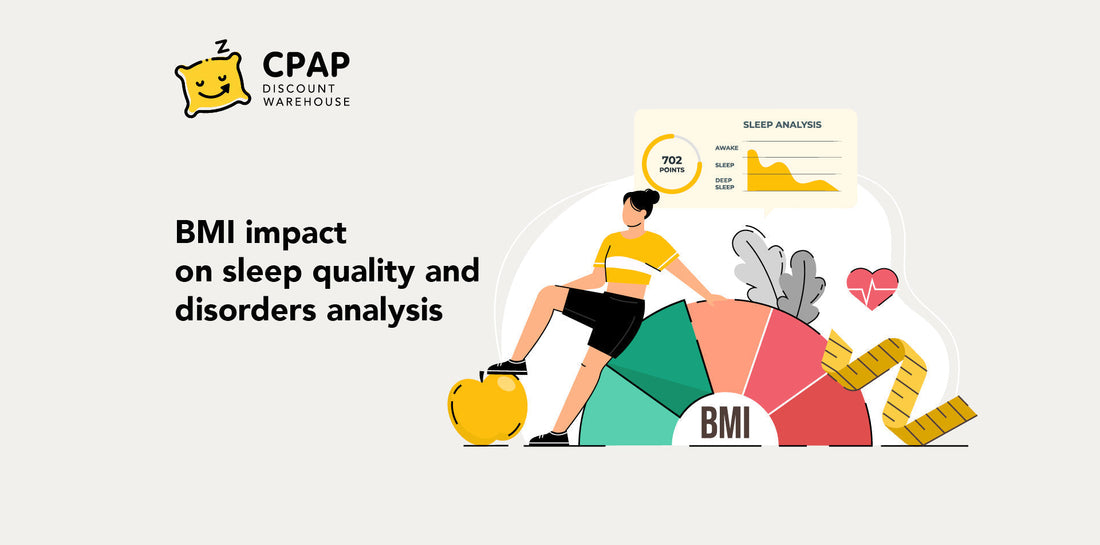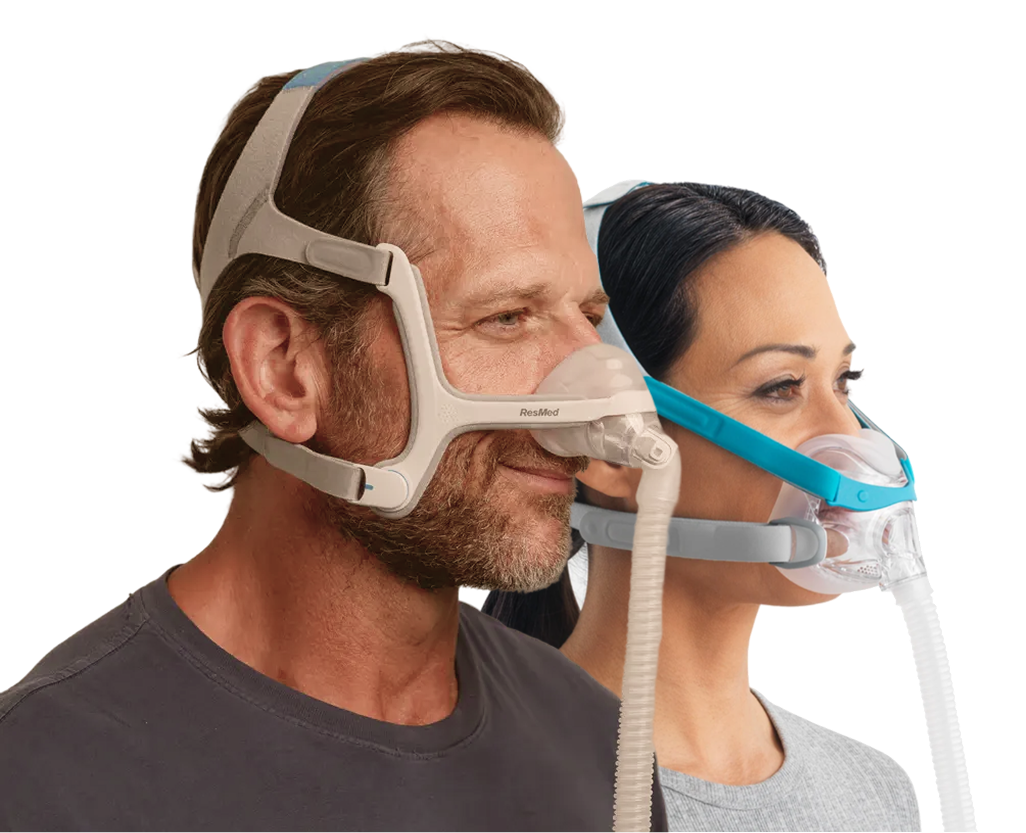What Is BMI and How Is It Calculated?
Body Mass Index (BMI) is a standardized measurement that relates an individual’s weight to their height. It is calculated using the following formula BMI = weight (kg) / height (m²)
BMI is used by clinicians to categorize individuals into different weight categories:
| BMI Range | Weight Status |
|---|
| Below 18.5 | Underweight |
| 18.5 – 24.9 | Normal weight |
| 25.0 – 29.9 | Overweight |
| 30.0 – 34.9 | Obese (Class 1) |
| 35.0 – 39.9 | Obese (Class 2) |
| 40.0 and above | Morbidly Obese (Class 3) |
While BMI does not directly measure body fat or health, it provides a useful indicator for assessing the risk of obesity-related conditions, including sleep apnea.
Overweight sleeping problems
-
Airway Obstruction: Excessive adipose tissue, particularly around the neck, can narrow the airway, leading to disorders like obstructive sleep apnea.
-
Respiratory Difficulties: Increased abdominal fat can exert pressure on the diaphragm, hindering proper lung expansion and reducing oxygen intake.
-
Melatonin: This sleep-regulating hormone can be disrupted by obesity.
-
Leptin & Ghrelin: These appetite-regulating hormones also influence sleep.
-
Insulin Resistance: Often associated with obesity, insulin resistance can affect sleep by causing changes in blood sugar levels during the night.
-
Systemic Inflammation: Elevated BMI often correlates with increased levels of pro-inflammatory cytokines, like TNF-alpha and IL-6. These can influence sleep architecture, leading to fragmented sleep or insomnia.
-
Metabolic Syndrome: Individuals with obesity are at higher risk of developing metabolic syndrome, a cluster of conditions including increased blood pressure, high blood sugar, and abnormal cholesterol levels.

BMI and Sleep Apnea
The Link Between BMI and Sleep Apnea Risk
There is strong evidence that a higher BMI increases the risk of developing sleep apnea, particularly obstructive sleep apnea. Excess fat, particularly around the neck and upper airway, can restrict airflow during sleep, leading to repeated breathing interruptions and oxygen desaturation.
Individuals who are overweight or obese are more likely to experience overweight sleeping problems such as loud snoring, daytime fatigue, and morning headaches all classic symptoms of sleep apnea. Studies suggest that approximately 70% of patients diagnosed with OSA are overweight or obese, highlighting the critical role of BMI in the pathophysiology of sleep-disordered breathing.
The primary linking obesity to OSA is the accumulation of fat around the neck and throat region. This excess tissue can:
+ Narrow the upper airway, making it susceptible to collapse.
+ Increase the likelihood of intermittent breathing pauses during sleep.
+ Contribute to reduced lung volume and more labored breathing.

Sleep Apnea BMI Chart
The Sleep Apnea BMI Chart is a risk stratification tool that helps clinicians identify individuals who are more likely to have sleep apnea based on their BMI.
| BMI | Associated Sleep Apnea Risk |
|---|---|
| < 25 | Low risk (unless other risk factors exist) |
| 25–29.9 | Moderate risk |
| ≥ 30 | High risk – Sleep study recommended |
| ≥ 35 | Very high risk – Possible severe OSA |
When to Consider a Sleep Study
While BMI is a helpful screening tool, it should not replace clinical judgment or formal sleep testing. A sleep study (polysomnography) is the gold standard for diagnosing OSA, regardless of weight.
Individuals with the following signs should undergo a BMI sleep study:
+ BMI ≥ 30 with excessive daytime sleepiness.
+ Loud snoring or gasping during sleep.
+ History of hypertension or heart disease.
+ Poor sleep quality or difficulty staying asleep.
Even individuals with normal BMI can have sleep apnea, particularly if they have other risk factors such as a narrow airway or family history.
Obesity, Hypertension, and Sleep Apnea
Obesity sleep apnea and hypertension are closely linked. Individuals with obesity are at increased risk of developing both OSA and high blood pressure. Moreover, untreated sleep apnea leads to repeated oxygen desaturations and increased sympathetic nervous system activity, which can worsen hypertension over time.
Research shows that:
-
Over 50% of people with OSA also have hypertension
-
Obese individuals with untreated sleep apnea have a significantly higher risk of stroke, heart attack, and metabolic syndrome
This makes it crucial for overweight individuals to screen for sleep apnea early, especially if they also have high blood pressure.
>>>> The Link Between Obesity and Sleep Apnea
Current Research Dynamics
-
Holistic Approach: Contemporary research is moving away from studying sleep disorders and obesity in isolation, instead focusing on their interconnected nature.
-
Technological Advancements: Wearable sleep trackers and telehealth platforms are becoming tools not just for monitoring but also for managing sleep disorders and obesity, providing real-time insights and immediate feedback.
-
Genetic Factors: Some studies are delving into genetic predispositions that might influence both BMI and sleep disorders, seeking to understand deep-rooted connections.

Managing Sleep Apnea in Individuals with High BMI
Lifestyle Modifications
+ Weight Loss: Even modest weight loss can alleviate some sleep disorder symptoms, especially obstructive sleep apnea.
+ Dietary Adjustments: Consuming a balanced diet, reducing caffeine intake, especially in the evenings, and avoiding heavy meals before bedtime can improve sleep quality.
+ Physical Activity: Regular exercise can help regulate sleep patterns and reduce the severity of sleep disorders. It's essential, however, to avoid vigorous activity right before bedtime.
Behavioral Interventions
+ Cognitive Behavioral Therapy for Insomnia (CBT-I): This evidence-based therapy addresses thoughts and behaviors that prevent individuals from sleeping well and replaces them with habits conducive to sleep.
+ Sleep Hygiene: Encouraging consistent sleep schedules, creating a dark, quiet, and cool sleep environment, and reserving a bed for sleep and intimacy can only be effective.
Medical Treatments
+ CPAP Therapy: This is especially beneficial for those with obstructive sleep apnea. The machine provides a steady stream of air to keep the airways open during sleep.
+ Medications: While many sleep aids exist, it's crucial to consider potential interactions with medications taken for other conditions often present in those with a high BMI.
+ Surgical Interventions: For severe cases, procedures such as bariatric surgery or surgeries to address sleep apnea directly might be considered.

>>>> CPAP Therapy: What It Is, Who Needs It, and Its Impact
FAQs
Yes, especially in mild to moderate cases. Weight loss can:
+ Decrease neck circumference and upper airway obstruction
+ Improve oxygen saturation during sleep
+ Reduce apnea-hypopnea index (AHI)
+ Follow a clinically supervised diet
+ Incorporate low-impact aerobic exercise
+ Improve sleep hygiene to reduce fatigue-related eating
+ Maintain CPAP therapy compliance for better energy levels during the day
+ Bariatric surgery may also be considered in patients with BMI > 40 and severe OSA.






